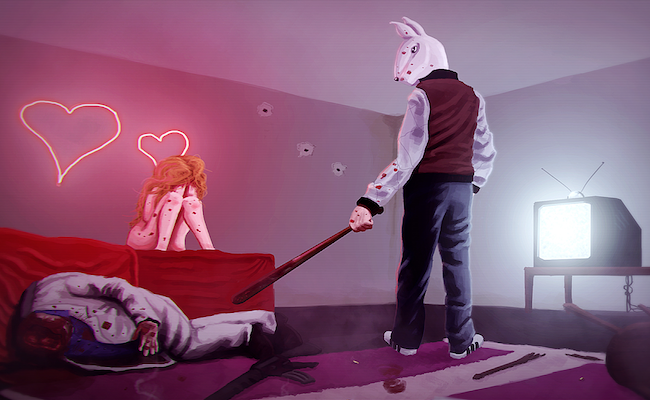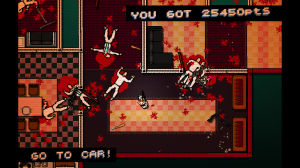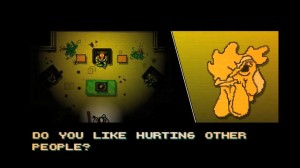
There is a message waiting for you on the answering machine. This isn’t too unusual though, it is 1989 after all. You listen carefully as you are informed that your order from the bakery should have been delivered by now. There is a list of ingredients included within, so please make sure to read them carefully. However, upon opening the package, there is not a single cookie to be found, but rather a chicken mask and instructions to kill.
You play as “The Jacket”, a name introduced by the fans due to lead characters lack of identity. This doesn’t mean he’s a nobody; it’s just that his name is not relevant. He is a man plagued by nightmares in which three strange masked figures converse with him. He’s done dreadful things, unforgivable things, so don’t expect to find anything straightforward about this story. You listen to the message, drive to the location and put on your mask. You kill everyone and walk out. Why do “you” do this?
The purpose of the game appears simple enough, just kill all the bad guys. It’s violent, provocative, but at the same time it has also been designed with careful precision. It’s a 2D top-down shooter. It’s a puzzle game. It’s a stealth game. In fact, Hotline Miami is a lot of things, and it is with great success that this blend of genres comes together to create something remarkable. This experience is not what it appears to be on the surface, as the developers often choose to reflect a mirror back on to the player.
You will begin each chapter by listening to an answering machine message. It always outlines a job that sounds pretty ordinary, but hidden within these words are the order to kill. You don’t stop to question it, you step into your car and prepare to engage the enemy. Once you arrive at the location, the player will enter the building and systematically find a way to kill everyone. It’s brutally straightforward.
Once the final person falls to the floor, that’s it. You slowly walk back through the massacre and step into your car. You leave it all behind you and drive to a local store, perhaps for a pizza or to rent a movie on VHS. The shop clerks all appear to look the same, but what does it matter, he doesn’t charge you anyway. This process will repeat itself throughout many chapters of the game, which upon conclusion will display a scoreboard outlining the players performance. If you killed well, you will be rewarded with new masks and weapons, but either way it’s time to wake up and do it all again.
Metaphors aside, there will still be many players that follow this process without questioning why. However, this is not without good reason, as the gameplay of Hotline Miami is insanely addictive. It is precise, and there is only one chance between you and the enemy, so if you fall, be prepared to start over. This will have you constantly reaching for the “R” key to reset and start the rampage over and over again, leaving many players unable to rest until they systematically find the perfect run.
The gameplay is presented from a top-down perspective and does well to implement a simplistic control scheme. The player will begin each mission entirely unarmed, but it only takes one punch to knock someone to the floor and one press of the spacebar to jump on top of them and perform an execution. It sounds easy, but it only takes one hit to kill you too. There are also various weapons available that will all kill with one hit, but guns can attract a lot of attention, so you might find yourself focusing on melee weapons. Once you see the combo meter flashing on screen, It will quickly become apparent how empowered this game makes you feel.
This brings us to the 1980′s inspired retro presentation, which might not look like much at first, but ultimately becomes an essential piece of the game’s presentation. The art style is pixilated, and the colours are often distorted, but it’s all a part of creating a fantastically dark world that reflects the characters actions directly back on the player. The experience has been designed to allow the player to detach from their actions as they sit from above and watch themselves lose control.
The soundtrack also has a large influence on the players perception. In between missions you will experience surreal and atmospheric music, emphasising the questionable reality of the main character. However, when you are engaged in a mission, the music becomes subtly aggressive and works well to compliment the players mindless urge to kill and reach the end of the stage. Once this has been achieved, the music cuts out entirely, and the player is then forced to walk back to the car in complete silence and contemplate what they just did.
The ingenuity of Hotline Miami is not in the story itself, but in the way the developers shape the experience to capture how we can mindlessly approach a game and just do as we’re told. The narrative of the game is incredibly surreal, so it’s possible for some to perceive this as an experience that is only focused on extreme violence. However, this is not the case, and whilst some players may walk away having just enjoyed the brutal and addictive gameplay, the outcome is completely reliant on your own perception. This is clearly not a game for the mainstream, but to those looking for a more mature theme of gaming, you will be surprised by what’s hidden within this pixilated and heavily metaphorical gem.















